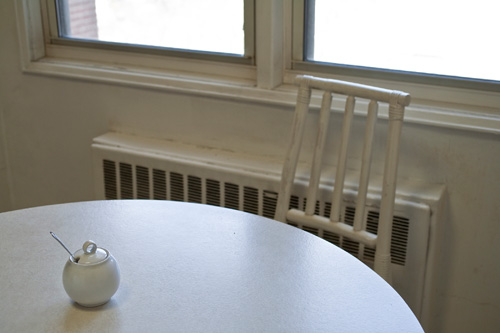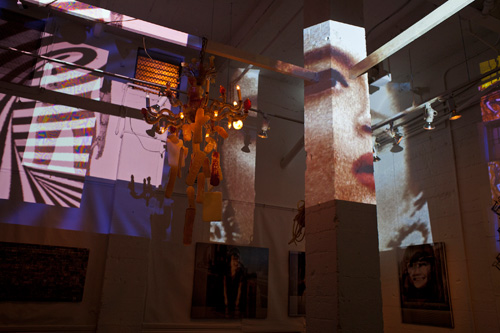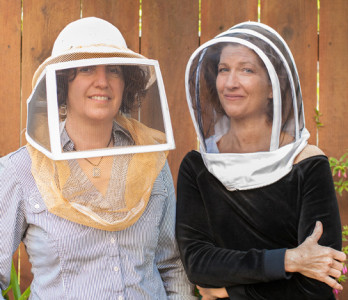
Glenna Cole Allee (right) and Victoria Mara Heilweil (left) make up the collaborative curatorial project known as MicroClimate Collective. The exhibitions they produce are thematic (Hypnagogia, Wabi Sabi, Night Light, Chance Operations, Unseen Unsaid, Everything Must Go!, Eidolon, Perfect Place/No Place, X Libris, A.D.D.) with strong considerations for the nuances of layered meanings within the language of the title, and appear to seek unexpected, if not surprising, interpretations across creative genres.
MicroClimate has a focus of interdisciplinary visual and performing arts programming which provides a context for cross-pollination between diverse circles of Bay Area artists. Their mission is to foster experimentation, collaboration, and risk-taking in an atmosphere free of commercial pressures.
Within this entity they have curated eleven multi-disciplinary exhibitions during the last seven years. They are currently preparing their twelfth, Obsidere which opens at Alter Space Gallery (San Francisco) on May 9.
Glenna and Victoria are both exhibiting visual artists, often working with photography. We chatted in late January in Victoria’s Mission District flat.
Whirligig: Individually, how did you come to be an artist?
Victoria: I started off doing film and video work while I was in high school and majored in that in college. While in college I also took quite a few photography classes, which is where I discovered that I loved all media that utilized a frame. I made an experimental film in college, and also did some less than traditional photography. I think I knew then that I wanted to be an artist, but feared that I wouldn’t be able to support myself and so didn’t immediately call myself that, or move in that direction. Out of college I worked first in the feature film industry in editing, and then in the commercial photo industry as a photo assistant and studio manager. While working I was still doing my own personal photography work, and it became apparent that I wasn’t cut out to be a commercial photographer. At that point I committed to getting my MFA and being an artist. I would say that it’s only been the last ten years that I have been really actively showing my work and moving my art career forward.
Glenna: I certainly tried not to. This fact of who we are, as artists, seems to be a wider circle that persistently swallows whatever other circles we draw. I tried to do other things and deny it but it wouldn’t leave, this predicament, “artist.” I have become better at putting parentheses around the resistance and the doubt. Recently I’ve been inhabiting a certain excitement and deep joy in working consistently, as well as a daily sense of appreciation for being able to make, and give time to, my work.
Whirligig: How did you come to be MicroClimate Collective and how do you think of yourselves inside of this entity?
Victoria: I had a friend who was the Artistic Director for the Climate Theater on 9th and Folsom Street. It was a small theater that had been around a while, but when she took it over she had a vision of it having other programming than just theater. She invited me in to check out a space she thought could work for visual art and asked me to tell her what could be done there. I gave her some suggestions and then she asked if I would run it. I had been doing some curating as part of my teaching at City College of San Francisco, but was definitely interested in doing more curating outside of that arena so I said yes. Very quickly I realized I needed help with this and invited Glenna and another artist to join me.
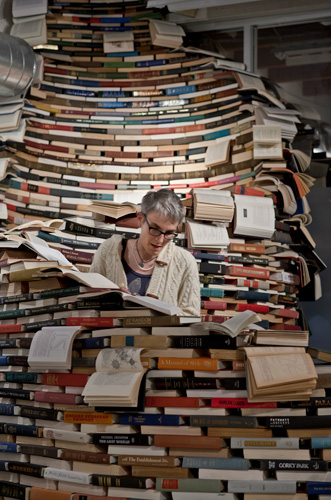
I knew Glenna from showing her work in the student gallery at City College. There was also a music series and a film series at the theater. The three of us joined forces with the three film series curators to put on one night shows that took over the whole floor. We showed all different media including music, performance and spoken word. It was exciting, but very tiring and eventually the other curators left to go on to other pursuits leaving just Glenna and I. We had decided after a few years that we wanted to start looking for other spaces to curate our thematic shows, and to have them last more than one night. Right about that time the Climate Theater lost their lease and closed, which forced us to move on.
I think of myself as one of the co-founders and primary co-curators of MicroClimate Collective. Glenna and I each have different strengths and wear different hats, although we can switch off if needed.
Glenna: I was just finished with an MFA and there was Victoria, beckoning. The MFA experience I’d just finished had been transformative–the constant company and critique of others who understood art as the main focus, having everything needed right there. I wanted to actively sustain dialogue and community, and this curatorial project seemed like a possible way. It was very interesting, to create a project together to try to foster creative community–the multi-genre shows might become a conversation between artists. That was one main motivation that drew me–the notion that MicroClimate might initiate work, and even collaboration between artists. It’s been a very satisfying thing, that we have inspired others in this way a little bit.
How I think of myself within MicroClimate: as an artist, with all my personal aesthetics and sensibilities, working intentionally to be a creative collaborator. Which entails seeking to meet halfway, and to be receptive/inviting to the third thing in the room, to what would not be created alone.
I often am in the role of filtering our ideas into language, of pushing to articulate our themes, and sometimes raveling them into little knots and back out again. I find this interesting; actually enjoy it.
Whirligig: What are the origins of this name?
Victoria: When we started curating at the Climate Theater one of the things we did was to have a project space for a single artist to create work for a month. At the time we called ourselves Climate Curators and the Project Space was MicroClimate as a play on the name of the theater and the smallness and specificity of the space. It turned out to be too much of a multi-use space that we couldn’t protect the artists’ work consistently, so we decided to let that part of the project go and only do the one night shows.
Glenna: It seemed an apt name for a small space/environment we wanted to create as distinct. To name this space for a micro-realm in which diverse artistic practices might converge in a complementary manner. The idea of “cross-pollination” also seemed apropos for the Bay Area, with it’s highly experimental histories.
Whirligig: You both work primarily in photography. Is this significant to your collaboration and/or the way you engage as MicroClimate Collective?
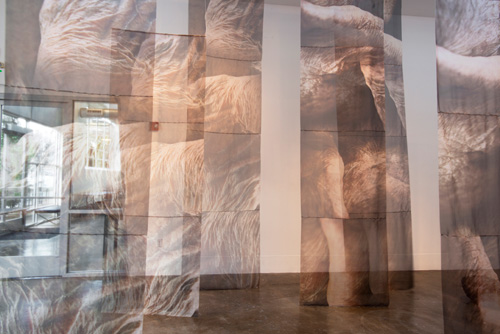
Victoria: I think Glenna might argue that she doesn’t works primarily in photography at this point! I don’t think it’s significant in how we engage as MicroClimate, or collaborate with each other. We are both very interested in all media including music and performance. Perhaps being a photographer helps me to sequence and layout work in the exhibitions as I am always working with a series of images in my own practice. It also gives me skills to document our shows well.
Whirligig: How does the focus of viewing the world through the lens affect both your curatorial work and your non-art life?
Victoria: I’m not sure that it does, and I’m also not sure that I really have a non-art life. I have a creative partner and child, so most aspects of my life encompass art. I love photography and teaching it to others including kids, but does that change how I view the world? The irony is that I take far less snapshots of my child, our friends and our vacations than my husband, who is not a photographer. I think my photographic practice is very specific in some ways.
Glenna: Lenses are fascinating in their variability, including the realms of damaged/imperfect lenses, which remind us of their own presence as portals! However I would not say I view the world “through the lens” in general. I do love the medium, practice and history of photography. It is a launching ground and a point of reference for most of my work so far, even as it has been jumping into installation and digital alternative photographic processes.
I’ve always been a slow, ruminative type of photographer, and somewhat low-tech, though I loved the mechanics and elegance of the 4×5, for example. I found the leap into digital practice a challenge, though I am now enthralled about a lot of it. But photography for me has always been a way of registering the world with a heightened attentiveness. It is still amazing to me, this practice of observation that reflects us back to ourselves. The realities of our deepest preoccupations, questions and sensibilities staring right back, sometimes startlingly.
So, my expanded art practice reflects my unconscious back to me, provides a window in to my own preoccupations/questions/observations. This sometimes informs the questions I roll out into curatorial practice. It is all a dialectical process.
Currently, having just realized a body of work long in the making, there’s a sense of the reality of art making as a means of creating ourselves, as formative, and the true need to remain in dialogue with other artists, and to give back to community.
Whirligig: How would you describe your aesthetic?
Glenna: In terms of my own work? Minimal and spare and pared down. I think that is in part why I love photography, which entails looking at things and looking again. My own work is ruminative and repetitive sometimes. I think that a somewhat minimalist aesthetic is one thing Victoria and I share, but we’ll see what she says. We have such different interests. Our work is so different, we are so different. . . so this shared aesthetic is one thing that tends to make us select work well together.
Victoria: I am also a minimalist. A big part of my aesthetic is beauty, but really surprising beauty. I like things that are made beautiful by some sort of transformation but don’t actually start off as anything that is beautiful. That’s really interesting to me. My other aesthetic has a lot to do with the mundane.
Whirligig: Your photographs seem more nostalgic to me than mundane.
Victoria: They are not nostalgic to me at all. No. No. Nostalgia to me embodies this idea of something that you miss or something that you feel was better. That’s not how I feel about any of my photographs.
Whirligig: The images of home?
Victoria: That’s my mom’s house. Those images are about her anxiety and her inability to function. They are not nostalgic.
Whirligig: It’s interesting how we interpret differently, and that context is so important sometimes to understand what the artist is after.
As MicroClimate Collective how do you describe your collaborative aesthetic?
Glenna: Probably one reason we work together really well is that we share certain aesthetics of work, and also of what will segue well thematically.
Victoria: I don’t know that MicroClimate has an aesthetic but we definitely have a philosophy that all of our shows have a variety of types of artwork in them and that includes performance and music and spoken word, so part of the conversation is to have the same theme run through as many media as we have access to.
Glenna: Which is difficult. Performance is the realm I feel least confident vetting. But I would not want performance to go by the wayside in our shows. Experimental music is also important to me to include and that usually swings right in. With performance a lot of times people propose something and then what they do is different, or it is really hard to tell what the performance is from what they send us. It’s hard. It’s painful sometimes.
Whirligig: Do you mean when the performance is different from what you envisioned from the proposal?
Glenna: Yes. When it’s something really different. We don’t select work just for the work. We select it to go with the other work. It is about a conversation. So it is hard when the performance is like a separate conversation.
Victoria: We go see a lot of art shows and are pretty good about seeing something on a computer screen and understanding how it will look in person. Sometimes it looks even better. We are not usually off about that. The only time it doesn’t work is sometimes when someone proposes something and then doesn’t follow through with what they proposed. But with performance it is really hard to tell. It is something about the fact that they are time-based, so when they happen it is very hard for people to not watch it. When they don’t go well there is this whole period of time. . .
Whirligig: Because people think it would be rude to leave during a performance piece.
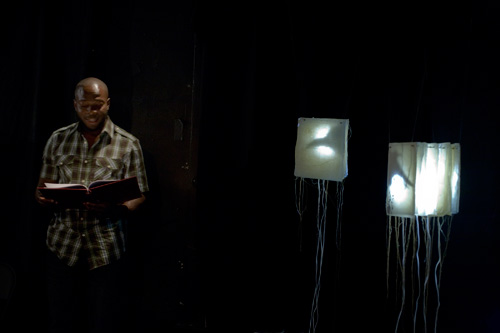
Glenna: But it’s not the same with music, and with spoken word where we have done really well; including these has often brought our shows to a whole new place. It worked.
Whirligig: How many shows have your co-curated?
Victoria: Eleven. The one we are doing in May is number twelve.
Whirligig: Is that separate from Climate Theater?
Victoria: No, that is including Climate Theater. We started in 2008 and are entering into our seventh year.
Whirligig: I think I went to one of your shows at Climate Theater.
Victoria: It was a really interesting space, but having to install that much work in one day and take it down the next was brutal.
Glenna: There were seven people at the height of it and that was very important, but it was a crazy amount of work. And we had to clean the whole floor, what we had to do to get the space ready. . . hide props and all the stuff that was in the space.
Whirligig: Do you go to galleries together? Do you share that as an activity?
Victoria: We have and also for the last couple of years have made a real attempt to go to MFA shows and MFA open studios together.
Glenna: We try to go to Mills, SFAI, CCA, Stanford, Berkeley. We also try, when we put out a call, to include people that didn’t go through those programs.
Whirligig: Did you have good MFA experiences?
Victoria: I had a terrible MFA experience at CCA twenty years ago.
Whirligig: Why was it terrible?
Victoria: I didn’t connect very well with the faculty in my own department. I didn’t actually have to work with them and I should have just not as I had better experiences with other faculty. They didn’t like any of the work that I did. I almost didn’t graduate. My thesis writing teacher at my final review told them they had to sign the papers, there was no way they were going to keep me there another year. So they did. But they barely did.
Whirligig: It’s not uncommon for people to have bad MFA experiences. How about you Glenna?
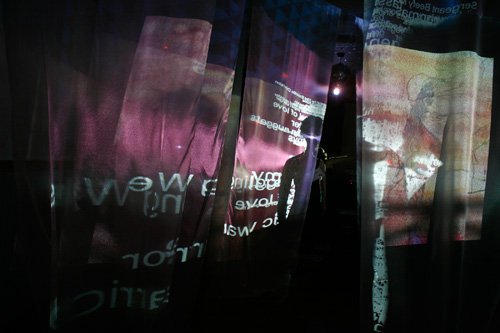
Glenna: I finished in 2007 and I felt so lucky to be there and to have everything I needed to make work 24/7, to have people be interested in it. It wasn’t warm and cuddly, and I guess it was competitive. SFAI had a lot of problems. They laid off eleven tenured faculty the year after I left and that was really problematic. I didn’t want to go back for awhile. But I felt so lucky to have their input. I didn’t find the mentorship that I wanted so much, although looking back I don’t know how much of that was my own fear, how much I was afraid to really connect and seek it. But I had an amazing experience. It was an amazing lucky thing to be able to do. I’d love to do it again. (laughs)
Whirligig: That’s what residencies are for.
Glenna: I wish I hadn’t been teaching for half the time. I actually stopped teaching towards the end.
Whirligig: Which MicroClimate exhibition do you feel was the most successful and why?
Glenna: (to Victoria) I am so curious what you say. (laughs)
Victoria: I don’t know. I guess it depends on how you measure success. In the shear number of people who came to the show, the first one might have had the largest attendance, maybe. It was packed. But I think that show, Night Light, was not as thematically tight and interesting as things we’ve done since then. For me, as far as how the work flowed together and fit together as a group, I really loved Wabi Sabi and X Libris.
Glenna: We agree about X Libris. That show had amazing spoken word. The other show that had that continuity was Hypnogogia. One of the co-curators at the time, Jen Cohen wanted to do a show on dreams. We talked that around and I found us the word hypnogogia which is the state between waking and dreaming. That show, all of the work and the way we had it arranged, brought you into quite a different state. There was a great musical performance by Philip Greenlief. That was perfect.
Whirligig: What was the least successful?
Victoria: There were two. The one for me that was the most disappointing was A.D.D. The other one that, although it had interesting work in it, it didn’t pull together in the same way and was weak or not well attended was Everything Must Go.
Glenna: A.D.D. I loved that show. I had trouble with Unseen Unsaid. I felt that it was very uneven. I didn’t think some of the work was strong and cohesive and it really fell down in places. A.D.D. was just hard because no one came, and it was in this weird space, but I actually thought it was a good show and there was such beautiful and amazing work. It was a companion to X Libris. The experience of it was no good because no one came. Although the opening was well attended.
Whirligig: What are some of the issues that challenge you as MicroClimate Collective?
Glenna: It feels like the Bay Area is very rich and that there are circles that spin in a familiar way, circles of artists, with people continuously coming out of art schools. Part of our project is to be bridging, to bring in people that aren’t already in contact and inspire inclusivity and connectivity. It is something that we want to push but this is not necessarily obvious in our thematic exhibitions. So, our project includes an ongoing open call for every show.
Victoria: We have always had a free open call because we believe in the democracy of art. Art should be accessible. Our open calls allow anyone to apply. What that means for us is that we have to look through a lot of submissions that aren’t the quality that we would hope. But every time there is at least one person that neither of us have ever heard of that is there doing this amazing thing.
Glenna: A lot of the process of selection of who gets known about or sold . . . the filters of the art world aren’t necessarily visible, but powerfully at work. So our open call is about reaching out. A lot of some of the best artists that I know didn’t get to get an MFA and never will, they didn’t get that time, and make work in the margins, so it is a conscious thing to try to open the door for people, and so that the shows can be more inclusive.
Victoria: When we look at work we just look at the work, sometimes it is interesting to look at where they went to school but that is not our criteria. I think what makes our collaboration really successful is also what makes it quite hard and that is that we are quite different. We argue about things. A lot of times we disagree and then we have to find our way out of those disagreements. I think that has made both of us have to think very carefully about what our positions are and what’s important to us. Sometimes that is not the most fun thing, but the end result is that we end up having a really rich dialogue. We have spent a lot of time learning how to work with each other and each other’s personalities.
Glenna: Victoria is very defined and likes to jump right in and be proactive. I can be so reticent. It’s a give and take. Each of us has learned to stretch and make room. It is interesting and wonderful, but it is not easy.
Whirligig: A lot of people can’t handle disagreement. It ends a lot of friendships and marriages and all sorts of partnerships, but when you can argue with someone, then you can be a real friend.
Glenna: It’s challenging.
Victoria: The economics of all this. . . We don’t get paid for doing any of this. We have talked a lot about the implications of this, and how we feel about it, and do we want to change it, can we change it? That’s a really complicated question and for me it is even bigger than our collaboration. Curators don’t get paid very much. I think there is real value in what we do. I think we get a lot back from it, but not in that realm and that can become difficult.
Glenna: I see it as we created this as a creative project and I don’t have any expectations for getting paid, although we got one grant and I would like to write another. I do see a problem in our potentially furthering the assumption that creative people will just work for free. I like our project. This is not a confusion about our project. The problem I see is the bigger world that we are in context with and what we might be replicating–the implications of the DIY ethos. In the same way that globalization and many formerly international economic practices that the U.S. exported to other places, and are now being brought home to places like Detroit, which is heartbreaking. It is the same way that punk culture and the practices of “Do It Yourself” or “We’ll just do it for free” have become work-force norms. Now you have free internships, and now there are these expectations that young people will volunteer and are just going to do all this work without compensation. There are just these bigger problematic cultural implications. We both do this curatorial project out of the time we steal from other things, which is a total privilege at this point in life, for both of us in different ways. I am thankful for that constantly. It’s the bigger canvas of projects like this that is problematic to me. Creative projects need to be funded. The question that comes up for me in creating a “free” project is “What are we really replicating?”
Whirligig: What have you learned individually from MicroClimate Collective?
Victoria: I’ve learned to be patient and listen, and to be a better collaborator. MicroClimate Collective also played an important role in connecting me to many excellent artists in the Bay Area that I continue to be inspired by, and have relationships with, both personally and professionally. It came at a time in my life when I wanted to have more of an artistic community around me, and when I wanted to be having more conceptual discussions around art. MicroClimate delivered both.
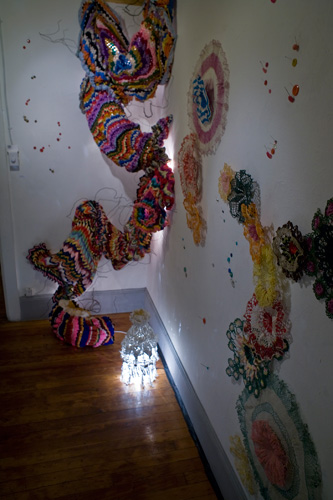
Glenna: I have learned how easy it is to roll out a mission statement, how hard it is to manifest those ideas, and how perseverance can be rewarding.
A great deal too about the challenges and rewards of collaborative process. It is this delicate teetering balance of give and take, and it is not an easy thing. We have had such a productive collaboration. I’m proud of what we have created together. And it has also been quite a fraught process. I’m a more reticent nature, somewhat perfectionist, and also quite strongly and seriously committed to the egalitarian collaborative balancing act. I’ve learned a great deal about self-assertion from our process, and about trusting and owning my own intuitive, sometimes less linear processes. I see collaboration as a modus operandi essential to any notion such as “future.” It is simply what we require more of. The arts can open up spaces for possibility and re-imagination, for generating different cultural paradigms. I try to see whatever difficulties of collaborative process in this broader context. This perspective is helpful.
Zipping into the curator suit in this project has been a bit of an education. I had curated before this project. But it’s not entirely a comfortable get-up for me. I am first of all an artist, and a peer of other artists, kin. I don’t like that fact to be eclipsed or in any way clouded.
Our project has pushed my own thinking about notions of “do it yourself,” “outside/inside,” etc. Nothing is “outside,” and nothing is “free.” There is an enormous amount of work (often not visible, or, out of focus), to make our shows happen, and even grant writing, once you believe in it’s efficacy, takes time. So much unrecognized time and work, it sometimes seems like the perfect mirror to the era we are in. . . despite our best intentions. The total sense of freedom and creativity are delightful, but it is problematic to call anything “free.”
Whirligig: Which art spaces in the Bay Area show the most engaging work?
Victoria: I don’t know, because there is a whole chunk of them I haven’t been to for a really long time.
Whirligig: Where do you always go?
Victoria: Where I go is not always because the work is the best or the most engaging. Having a child I have limited time. What’s most important to me is to make sure that I show up for friends or for spaces that I have a relationship with, so that is what I prioritize. I don’t always love the shows but I think it is more about the relationships rather than about the inspiration, which is what it used to be, but I think that has shifted for me.
Glenna: I am guilty of the same thing. I think one of the reasons I do this project of ours is so that I must continuously get out and see things. I can get overwhelmed and just want to focus on my own work. I pay attention to Southern Exposure, SoMarts, Intersection, the Headlands. I go to Yerba Buena. I don’t know that I could venture to say who shows the most interesting work. I love what is coming out of Southern Exposure. Can we put The Tenderloin National Forest on that list. I love what he does, Daryl, who started the Luggage Store.
Whirligig: How would you describe the current Bay Area Art Scene?
Victoria: Wow. There are a lot of ways to answer that. It is a tough time for a lot of people. We are going to continue to lose really great artists and really great galleries because they cannot afford the prohibitive amount to live here now. It’s a very melancholy time. People are feeling losses.
One of the things that is very popular in the Bay Area is social practice, parts of which I find interesting and parts I don’t. That’s a big movement here. Another movement here is conceptual work that is a little bit colder, more intellectualized.
Whirligig: More academic would you say?
Victoria: Yes. That’s not everything, but those two strains are very powerful here right now.
Glenna: That’s a really hard question because I feel that there is so much more now than when I moved here. There’s this burgeoning happening, and then there is this packing and moving. So many people have left. So many things are moving to Oakland, and now Oakland is experiencing this pressure, it is an incredibly over-the-top bubble. It’s confusing. I’ve been here 20 years and really hoped it would be home. I came here for the kind of myth that I think still hangs over San Francisco and is magnetic to people looking for a certain something. It always felt like it was off beat, and it is not like New York, where I came from. It had an infinity factor–it’s a port and has a sense of expansion in a big way. But now it feels like it is really hard for little fledgling entities to establish themselves, smaller, experimental galleries to form and to remain. Even the big ones are camping out in weird places.
Victoria: Or closing their doors for all kinds of reasons.
Glenna: It’s very weird and now Oakland seems to be in many ways thriving, but there is so much being displaced also. It is like an intensification of a story that I’ve seen in a lot of other places.
Whirligig: What do you find interesting in contemporary art?
Glenna: (with quiet angst) god. (to Victoria) You go.
Victoria: I don’t even know how to answer this.
Glenna: I’ve been looking at less current work recently. I’ve been looking at Sophie Ristelhueber who is a photographer. I just love the way she thought about place. I’ve been looking at Roni Horn, all of her work. Some earlier workand some more recent that I wasn’t immediately blown away by, but I trust her work so much that maybe I am just not seeing it yet. I’m also jumping into sculpture in my own practice so I am looking at Eva Hesse. I’m looking at things that I loved when I first found them and then have not looked at in a long time. I go to New York periodically and see everything that I possibly can and write lists. Then sometimes I lose the list. I found one recently and said, Oh yeah! I’m looking at installation and sculpture because my work is, not exactly going away from photography, but it is seeking other forms of expression as well. What is interesting is all over the map, for me now.
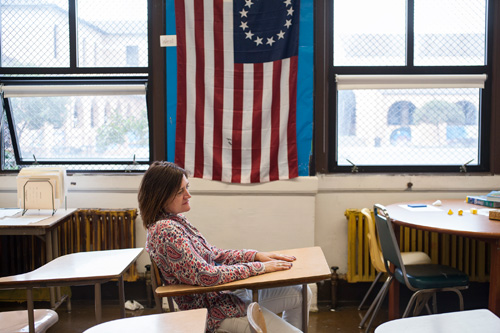
Victoria: There are lots of things that interest me. If I think about my own media, photography, I think we are living in a very interesting time because you can make images in so many different ways now, there are so many different ways things are done. I like that people are thinking about how to push their media. Sometimes I connect with things just because of the quality of it, sometimes the idea, sometimes it’s both.
I can tell you about a show I saw recently in L.A. that was amazing. At LACMA, a French artist I had never heard of, Pierre Huyghe. The show had a live dog walking around with a pink leg. There was a guy in a tuxedo who announced your name when you walked into the show. There were live plants, terrariums with fish everywhere and a beehive outside. For a museum to do this is extraordinary.
Glenna: What do you mean by a pink leg?
Victoria: It was pink. They had dyed it pink. He said that what he does is create experiences, they are not installations. I spent at least two hours at this show. It was unbelievable. Thing after thing after thing was so out there, but so amazing and some of it was so beautiful. But just crazy and creepy and dark. It was everything. I never had heard of him before at all.
Whirligig: What did it mean?
Victoria: I don’t know exactly. The friend I went with said it was sort of like walking around in somebody’s mind. There was definitely stuff in there that related to global warming, but it was very obtuse.
Whirligig: Do you think it is important for audience to grasp what the artist’s intent is, or the meaning behind work?
Victoria: I don’t know if they always have to grasp all of it. I think it is important that people feel something. That they respond to it and that it makes them think about something. But you can’t control what they think about it and it is not always what you intended.
Glenna: Grasp is a funny word. A lot of my favorite work is oblique as in, “not directly stated.” I understand it in new ways over time. To say that I could grasp it would be like saying that that wouldn’t keep happening. But I also think it depends on the kind of work. Some work you can just feel very intuitive and that is a different kind of response. Some work you want to figure out what they are trying to say, and it is a process of trying to get there. Grasp sounds so . . . there is a lot I don’t grasp, and some things take me awhile to come to terms with or understand completely.
Whirligig: All of us.
Glenna: I’m very slow. Some people can walk right into work and ramble right away about it, but I am always very slow.
Whirligig: Do you think Victoria comprehends work quicker than you.
Glenna: I’ve never thought about that. I think we comprehend work differently. I know a lot of people who verbalize quicker than me and I like going to see work with them. And in critiques also I love when people can see things in work and tell you what they see. Sometimes I can, but a lot of the time I can’t immediately, or I can much more quickly in writing. We are all different that way.
Whirligig: How do you sustain your art practice?
Victoria: By constantly recommitting to it and making sure I give it time. For ten years after graduate school I was still making plenty of work but I didn’t show it, so I’ve spent the last six years trying to put it in the world, and that takes its own time. Right now I feel like I got a lot of things I want, and am trying to keep up with it. I’m changing what some of my focus is.
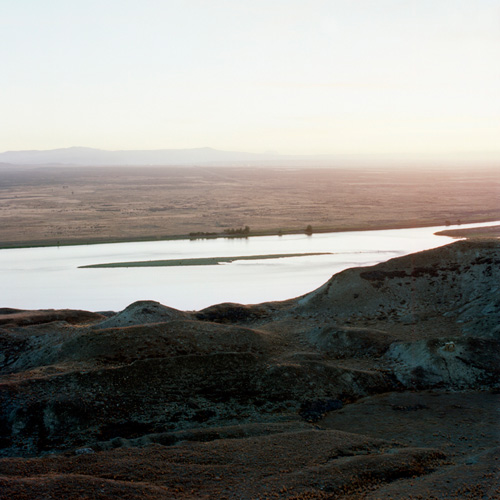
Glenna: It’s really hard for me. I went into a tailspin after grad school. To make work felt very expensive, although not so much now. It’s been in part a matter of finding dialogue. I initiated a critique group after grad school and that really saved me because a lot of us who had shared that experience kept talking, until several people moved away. There’s so much importance in not just feeling in it alone. Having deadlines is also) helpful. I have some ideas that can grow over time and sit on the back burner, but to really push them I have been trying to bring in collaborators. I love that. I just ended a time of being in my studio as much as I could. I can become afraid of stopping once I am working. How to keep going, to keep this intensity, and also to live life with balance, may be a life-long tight-rope walk for me. Right now, I am afraid of stopping and losing momentum. I have a lot of ideas that I am so excited about and that I can deal with, so it is a really exciting time. But it has been a challenge for me to cultivate and to sustain my practice continuously.
Whirligig: And how are you sustaining your collaborative curatorial practice?
Victoria: We regularly talk about whether we want to continue and what it means to each of us, and how we work together, but both of us are not ready to stop. We’ve decided we can’t do more than one show a year. When we’ve done more than that it is really tough. And especially when we do two that overlap. That won’t happen again because that was brutal. We are trying very actively right now to bring in another person. We didn’t start off the two of us and it was never intended to be just the two of us. So we are bringing someone in for one show and seeing how we all work together and to mix it up. I would like to see at least one more person become a core person who is involved and committed, become engaged for the long haul, but that hasn’t happened yet.
Glenna: At least. I would like to see a larger group and have the dynamics of that. I would say that is the most important thing we’ve done, to bring in other people to work with us. Because we have very different natures and it is not a matter of either of us being wrong or right, but about going back and forth and getting polarized. It is so important to have another point of view to make a more interesting conversation in which we are all listening and finding what we wouldn’t have thought of just ourselves–that amazing synergy. I am so excited that we have Claudia Tennyson working with us on our next show. Her work is extraordinary, and it already seems like it’s going to be this generative meeting. It is a stretching endeavor and it is so productive.
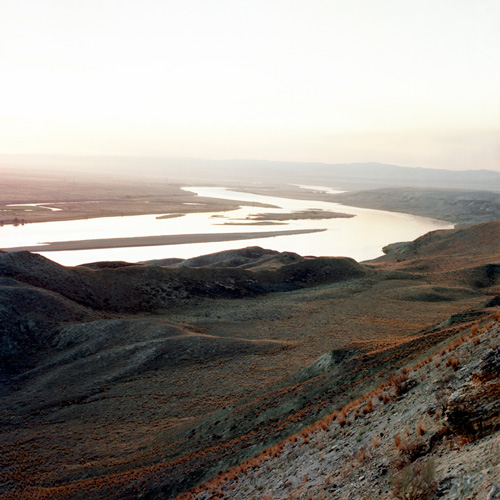
Whirligig: What is that next show?
Victoria: It’s on the theme of obsession. It’s going to be at Alter Space.
Whirligig: A lot of artists are obsessive it seems.
Glenna: Well that’s the problem, everything is obsessive, but there are ways that it will need to be narrowed.
Whirligig: What are you working on now individually.
Glenna: I’ve just finished a project on generational time and age: a show at the University of the Pacific that included my own work and the work of two other artists. Now I am working on a project addressing the Hanford Site, the Manhattan Project area where they invented plutonium. I see it as in some ways a forerunner of the current “black sites”. Hanford was an enormous project built in an incredibly short time in total secrecy. So my project involves newly mapping this site with an installation and gathering some of it’s histories. I’m jumping into this project with video, photography and sound.
Victoria: I have a series call Sisyphus which are photographs of my dirty dishes that are meant to be a really, really large archive that the prints are mounted and installed, but not in a regular grid. That’s not done yet. I would like to find a place to do a big installation of those.
The other project is kind of a big departure from the other work I’ve been doing, but I feel really motivated to do it. It’s called No Child Left Behind. As somebody who has both been an educator for twenty years and now has a child in public school, I have reached my limit with how teachers are treated and talked about, and about how broken our education system is, and that it is all blamed on teachers. I have experienced first hand how micro-managed they are right now and how nobody trusts them to do their jobs. I spent a lot of time ranting about it and then decided I should do something so I started photographing teachers. It is a challenging project because it is so different from the work I normally do and I don’t think it is a gallery project. Where it goes and how it manifests is going to be different. So I am still trying to figure out exactly what it is suppose to be doing. I just know I need to make it. I put it aside for a few months and then in the fall I photographed a bunch more teachers. I am going through the images now and I feel like it is getting closer.
Whirligig: Describe a curatorial project that would be ultimately fulfilling, but impossible for you to pull off.
Victoria: I don’t know if I have one, but Glenna might!
Glenna: I have this idea to create a SwimMuseum. A museum with excellent exhibitions created to swim through, an actual “immersive” experience.” I get tired sometimes of the way we toss terms around, even as I am guilty of this laziness myself. The SwimMuseum would deliver the real article–actual immersion in art.
The museum/gallery experience can be kind of static and restrained–a predictable convention. I have not yet attended a Biennale. The mere idea seems overwhelming even at great distance; I’m afraid I would travel all the way to Florida or Venice only to scrabble to find a rock or lump of gold to crawl under to hide until it’s all over.
How much less static, how pleasurable might it be to encounter excellent artworks selected to keep each other company while gracefully and effortlessly moving through the most fluid environment possible?
The SwimMuseum would be a truly excellent art experience of some magnitude and seriousness, while playful–not a Disney-style or Burning Man gimmick. And my conviction is that it would be free, which seems difficult if not absolutely Impossible. Daunting. Perhaps there would be a very large admission fee for those making over a certain amount a year. . . hmm. . . they could carve their own names in the sand, by the entry. . .
I’ve been thinking about how to make a maquette of this idea.
MicroClimate Collective
Glenna Cole Allee
Victoria Heilweil
Images from the top: Victoria Mara Heilweil and Glenna Cole Allee; Dee Dee Kramer spoken word performance in Biblio Babel by Glenna Cole Allee and Yulia Pinksuvich from X Libris. Photo: Victoria Mara Heilweil; 1912 at Reynolds Gallery, University of the Pacific. Photo: Glenna Cole Allee; 47 Years: my seat, 2012, Archival Pigment Print, 17 x 22″ Victoria Mara Heilweil; Myron Michael spoken word performance with Elyse Hochstadt sculptures from Eidolon. Photo: Victoria Mara Heilweil; Double Vision from X Libris. Photo: Victoria Mara Heilweil; killer banshee (Eliot K Daughtry and Kriss De Jong) from A.D.D. Photo: Victoria Mara Heilweil; Stephani Matinez from Hypnagogia. Photo: Victoria Mara Heilweil; Jenifer McKitrick, Economics and History, Balboa High School, 2014, from the series, No Child Left Behind, Archival Pigment Print, 13 x 19″ Victoria Mara Heilweil; Hanford Duo left, Glenna Cole Allee; Hanford Duo right, Glenna Cole Allee; Sisyphus 1, 2013, Archival Pigment Print, 17 x 22″ Victoria Mara Heilweil.

